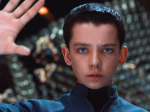▼
◆ by Lucy Morrell
Set in the future following an insect-like alien species’ near destruction and failed colonization of Earth, Ender’s Game is written and directed by Gavin Hood (X-Men Origins: Wolverine) and is based on the first book in Orson Scott Card’s popular Enderverse science fiction series in which human leaders train gifted children for warfare in order to defend against any further attacks. Ender Wiggin (Asa Butterfield), a brilliant strategist and a child-sized cocktail of empathy and aggression, is humanity’s last hope. At just under two hours, the movie speeds through the events of the book, hitting all the highlights but diminishing each moment’s import in its simplification.
The implications of war, nevertheless, are made all the more intense by the active participation of children. But while the film is able to convey the overarching story and themes, it loses some of the more striking aspects of the book by substituting stock scenes for unique development.
The audience doesn’t actually see how Ender earns the trust and loyalty of his highly competitive peers, but he must because in one scene the children relocate en masse to his cafeteria table from his rival’s. The movie reduces a complex fight for allegiance and power to a petty display of lunchroom dynamics, which could just as easily be in any movie ever set in a high school.
General Graff (Harrison Ford), who oversees Battle School and takes a singular interest in Ender, is unnecessarily injected into scenes. His shouting never changes, but seems to act as a running commentary for the audience to recognize just how special Ender is — instead of allowing us to see for ourselves. In the book, Ender is always special but it often feels he is being singled out for mind games rather than epaulettes. With Harrison Ford constantly pushing him to high command, there is no such ambiguity. The focus shifts from Ender’s development in Battle School to the uninteresting and unchanging world of adults.
Ender is complex, and Asa Butterfield is expressive; he can handle the pressure of a close-up with no explanatory dialogue. The characters surrounding him, though, especially his siblings, are hopelessly two-dimensional. His brother appears only long enough to choke Ender in a fight, barely hinting at the sadistic cruelty he demonstrates in the book, and Valentine, played by a pouty Abigail Breslin, is no more than the overly empathetic female — valuable only in her concern and intuitive understanding. Of course, this is part of the point; Ender is the goldilocks just-right mixture for military command.
If you haven’t read the book, though, you won’t see the compromises, only the cleverness, for regardless of all that it skims through and cuts short, the movie has some awe-inspiring human ingenuity against a backdrop of stunning CGI.
[Image at top of post: Asa Butterfield as Ender Wiggin.]The Ryder ● December 2013
▲

